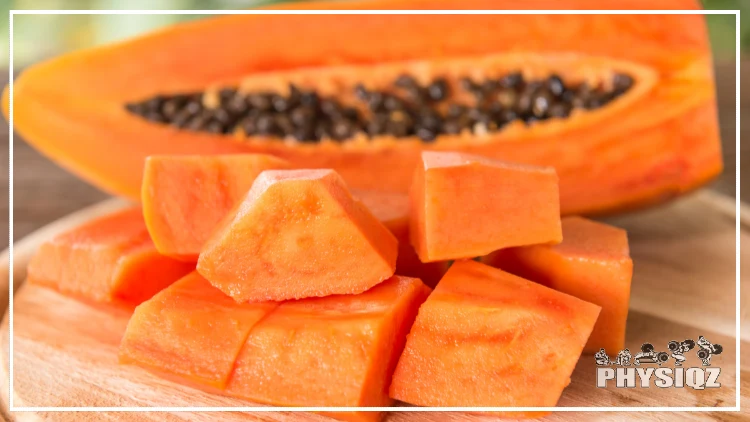
Papayas, known for their sweetness, contain a moderate amount of carbs and might be suitable for a keto diet in small amounts. However, they are truly keto-friendly only when fermented.1
So check out how fermentation changes the carb contents, how to make papaya chutney and 7 keto alternatives that are lower in net carbs and should be considered instead.
How Many Carbs Are In Papaya?
Papaya is a great source of vitamins and minerals, including Vitamin C, Vitamin A, potassium, and magnesium.
For those wondering about the potential weight loss on keto, it definitely is not a diet to go on in order to get into a 1000 calorie deficit, but it is possible to be in a deficit while eating papaya; it is low in calories, making it a great fruit choice for those watching their waist.

Source: utah778 via Canva.com2
Nutritionally, according to the U.S. Department of Agriculture, fresh papaya includes the following nutrients per 100 grams:3
- Calories: 43
- Fats: 0 grams
- Protein: .5 grams
- Carbs: 11 grams
- Net Carbs: 9 grams
- Fiber: 2 grams
- Sugar: 8 grams
Dried papaya, on the other hand, is a bit more nutrient-dense, solely because any water has been drained from the papaya, making it contain more of the actual fruit per 100 grams:
- Calories: 295
- Fats: .5 grams
- Protein: 1 gram
- Carbs: 75 grams
- Net Carbs: 70 grams
- Fiber: 5 grams
- Sugar: 68 grams
For the keto dieter, the main nutritional content that matters is net carbohydrates. Net carbs are calculated by subtracting the amount of fiber and sugar alcohols from the total carbohydrates. This means that fresh papaya has a net carb content of 9 grams per 100 grams, and dried papaya has 70 net carbs per 100 grams.
Overall, this suggests that while fresh papaya can technically be consumed on a keto diet in small quantities, dried papaya should be avoided due to its high net carb content.
Can You Eat Papaya on a Keto Diet?
Considering 100 grams of papaya has 9 grams of net carbs, it’s not a very keto-friendly food. While a person could technically eat papaya while on the keto diet, it would need to be in moderation and as part of a carb-controlled meal plan. To answer the question of whether papaya can be eaten on the keto diet: technically, it is permissible, but it is borderline in terms of what is generally accepted.
However, there is discussion over how fermenting papaya can allow it to be consumed in greater quantities on the keto diet; this is something that will be discussed further along in this article.
Is Green Papaya Keto-Friendly?
Green papaya is actually the same as normal fresh papaya. The only difference between the two is that they are picked at different stages of development; green papaya is picked before fully mature, while orange-fleshed papaya signifies that it was harvested when fully mature.
Green papaya has white flesh and has overall little flavor. Standard papaya is great as a snack for people looking for a sweet, melony taste, but green papaya is typically used as a base for salads due to the crunch it offers.
That being said, because green papaya is simply regular papaya harvested at an earlier stage of development, it shares the same nutritional value as regular papaya:
- Calories: 43
- Fats: 0 grams
- Protein: .5 grams
- Carbs: 11 grams
- Net Carbs: 9 grams
- Fiber: 2 grams
- Sugar: 8 grams
Considering this, the main takeaway from the article is that both regular and green papaya can be part of a keto diet. But, there is one way in which papaya can be regularly consumed on the keto diet: post-fermentation.
When Can You Include Papaya in a Keto Diet?
Papaya is a nutritious fruit with many health benefits, but it’s not a very keto-friendly food because of its high carb content. However, papaya can be consumed on the keto diet in moderation or when it is fermented.

Source: RossHelen via Canva.com4
As aforementioned, 100 grams of papaya contains roughly 9 grams of net carbohydrates, meaning a person could technically eat up to 200-250 grams of papaya before reaching the lower limit of staying in ketosis. This means that it can be consumed on its own while in keto, but keep in mind that this is not that much fruit. Lowering carbohydrate consumption, in general, can reduce bloating, and even further than that, potentially help to harden muscles more easily, so eating papaya on keto may make this more difficult.
On the other hand, when a food is fermented, the number of carbohydrates inside of it lessens due to specific cellular mechanisms that break down the sugars inside into fatty acids. So, when papaya is fermented, it essentially ‘loses’ carbohydrates, which makes it an even more viable fruit to consume on the keto diet; ultimately, this makes papaya a more keto-friendly food.
So, to reiterate the main point of this section, papaya can be eaten on the keto diet, but it should be consumed in moderation as part of a carb-controlled meal plan, or even better, it should be fermented in order to allow for consumption of more overall fruit.
How Fermentation Lowers Carbs in Papaya
In complex terms, fermentation lowers carbs in food in general through three phases, but the first two phases are the only ones needed to understand how fermentation affects carbohydrate amounts.5
In the first phase, complex carbohydrates are broken down into simple sugars. In phase two, these simple sugars are essentially ‘eaten’ by the good bacteria that happen during the fermentation process – this is where the reduction in carbohydrates occurs. The bacteria use these simple sugars as a food source to grow and break down the food further.
A similar process can be observed in foods other than papaya. For example, think about how sourdough yeast operates; it is fed a small amount of sugar for it to ‘feed’ off of, allowing it to culture. A different example can be seen in the creation of kombucha, where black tea combined with sugar is put into a sealed container with a bacterial colony that feeds off of the sugar to eventually create kombucha.
For vegetables and fruits alike, the fermentation process is perfect to reduce the number of carbohydrates in them. They typically contain ample amounts of sugar that can be consumed by bacteria during the fermentation process, and for papaya, that is exactly the case.
When papaya is fermented, roughly half of the natural sugars that are part of the carbohydrates are ‘eaten’ by the bacteria – leading to a reduction in carbs. This makes papaya a more keto-friendly food, as it contains fewer carbohydrates overall.
It’s important to mention that there are currently no studies that conclusively determine the percentage of carbohydrates consumed during the fermentation process, whether it’s 50% or even 100%. This is akin to thinking about the insignificance of the scale; a person can track their carb intake or weight all they want, but sometimes, it will be impossible to be accurate.
All that can currently be said is that some carbohydrates are lost, so try not to make it a habit to rely on fermented foods because their true net carb count is vague, at best.
Recipe To Make Fermented Papaya Chutney
This recipe is for a low-carbohydrate, fermented papaya chutney that can be used as a condiment or spread.
Ingredients:
- 1 cup finely chopped papaya
- 1 cup finely chopped pineapple
- 1/4 cup diced onion
- 2 cloves minced garlic
- 1 green chili, diced
- 1/2 teaspoon salt
- 1/4 teaspoon turmeric
- 1/4 teaspoon cumin seeds
- 1/4 cup white vinegar
- 1/2 cup water
- 1 papaya leaf to garnish (optional)
Instructions:
- Combine all the ingredients in a bowl and mix well.
- Transfer the mixture to a glass jar or container and close it tightly.
- Keep the jar at room temperature for 3-4 days, opening it once a day to release any built-up pressure.
- After 3-4 days, store the chutney in the fridge and use it as needed.
This chutney can be used as a condiment or spread on low-carbohydrate wraps or flatbreads. It can also be added to curries or stews for additional flavor. While eating fermented foods isn’t one of the fasting facts proven to help a fast, eating things like fermented papaya chutney can help to maintain satiety.
There are many fermented papaya chutney recipes out there, but this recipe aims to combine ease of access with good flavors. Typical recipes require some form of culture starter in order to begin the fermentation process, but this one makes things simple.
The addition of vinegar to the recipe, combined with leaving the fruits and vegetables in the chutney out at room temperature will allow good bacteria to form and slowly break down and eat away sugars in the chutney. For someone who wants this process to be even more accelerated, there is also the potential to add lime juice for extra acidity and quicker fermentation.
Overall Health Benefits of Papaya
Papaya is a nutritious fruit with several health benefits. It is rich in vitamins, minerals, and antioxidants, which can help boost immunity, protect against cellular damage, and improve skin health.

Source: ildipapp via Canva.com6
Papaya also has anti-inflammatory properties that may help reduce inflammation and oxidative stress. Additionally, papaya is low in calories and contains fiber, aiding in weight loss and digestion.
In order to understand the true benefits of consuming papaya, take a look at this list of all the benefits that normal papaya can potentially offer a person:
- High in vitamins C and A
- A good amount of fiber
- Contains papain, an enzyme that helps in the digestion of meat
- Powerful antioxidant effects
- Contains lycopene which is purported to reduce cancer risk
- Contains high levels of carotenoids which help to reduce inflammation
- Improved digestion and reduced bloating7
But the benefits don’t stop there; the above list only accounts for what standard papaya can offer a person. Fermented papaya comes with a list of benefits on its own, on top of the aforementioned benefits:
- Potent immunity booster
- Helps to mitigate Alzheimer’s disease and dementia
- Anti-inflammatory
- Protects against cellular damage
- Improves skin health
- Anti-anemia
- Eliminates free radicals
One thing of note is that the current research on fermented papaya suggests that further studies are needed to understand the mechanisms in play that allow fermented papaya supplements to offer such potent effects, especially when compared to unfermented Carica papaya extracts.8
Overall, papaya is a nutritious fruit with many health benefits that are only emphasized when fermented, making it quite an interesting thing to think about. However, one thing to keep in mind is that for people seeking to jump start weight loss, consuming papaya could be a great idea. It is essentially a low-calorie superfood, but no one ever talks about it.
Suggested Reading: Jackfruit Keto: Sugar Alert (10 Keto Fruits & Meat Alternatives)
7 Alternatives Low Carb
There are quite a few fruit alternatives to papaya that have a lower or similar amount of net carbs per 100 grams, whether due to having overall fewer carbohydrates, or more fiber. These fruits include:
Honeydew: 8 grams of net carbs per 100 grams
Cantaloupe: 7 grams of net carbs per 100 grams9
Watermelon: 7 grams of net carbs per 100 grams
Strawberries: 6 grams of net carbs per 100 grams
Raspberries: 5 grams of net carbs per 100 grams
Blackberries: 4 grams of net carbs per 100 grams
Avocado: 1 gram of net carbs per 100 grams
The biggest difference between papaya and these foods is how much can be consumed before potentially falling out of ketosis.
For example, 100 grams of watermelon is far more than a person would be able to logically expect. 92% of the weight of watermelon comes from water, meaning out of 100 grams of watermelon, only 8 grams are actually a fruit that contains calories.
Papaya, on the other hand, has 88% of its weight come from water. This may not sound like that substantial of a difference in weight, but in reality, it makes it quite a bit more difficult to fit papaya into a keto diet.
This difference in density is what makes these low-carb alternatives more viable options, as they can be consumed in larger quantities without having to worry about falling out of ketosis.
While papaya does contain 9 net carbs per serving, it can be eaten in moderation on a keto diet. However, people should be aware of how much carbs they are consuming when eating papaya and other fruits. Knowing this, it should be quite easy to answer questions such as whether papaya is keto-friendly.
References
1Casarsa. Canva. Accessed 13 April 2023. <https://www.canva.com/photos/MAEE-X-OABk-fit-woman-eating-papaya/>
2utah778. Canva. Accessed 13 April 2023. <https://www.canva.com/photos/MADAKyKjvyk-papaya/>
3U.S. Department of Agriculture. (2019). FoodData Central Search Results. FoodData Central. Retrieved November 8, 2022, from <https://fdc.nal.usda.gov/fdc-app.html#/food-details/169926/nutrients>
4RossHelen. Canva. Accessed 13 April 2023. <https://www.canva.com/photos/MAD277iEMjU-portrait-of-a-woman-licking-papaya-fruit/>
5The University of Maine. (2022). Fermentation – Carbohydates – University of Maine. The University of Maine. Retrieved November 8, 2022, from <https://umaine.edu/carbohydrates/carbohydrate-digestion/fermentation>
6ildipapp. Canva, 20 April 2019. Accessed 13 April 2023. <https://www.canva.com/photos/MAA8u8cLtHI-fresh-papaya-juice/>
7Muss, C., Mosgoeller, W., & Endler, T. (2013). Papaya preparation (Caricol®) in digestive disorders. Neuroendocrinology Letters, 34(1), 38-46. <https://pubmed.ncbi.nlm.nih.gov/23524622/>
8Leitao, M., Ribeiro, T., Garcia, P. A., Barreiros, L., & Correia, P. (2022). Benefits of Fermented Papaya in Human Health (W. Kolanowski & A. Gramza-Michalowsk, Eds.). Foods, 11(4), 563. <https://www.ncbi.nlm.nih.gov/pmc/articles/PMC8870802/>
9U.S. Department of Agriculture. (2019). FoodData Central Search Results. FoodData Central. Retrieved November 8, 2022, from <https://fdc.nal.usda.gov/fdc-app.html#/food-details/746770/nutrients>